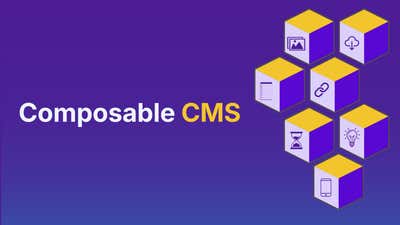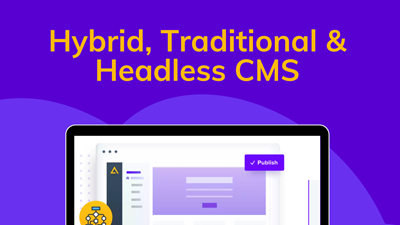Why Brands are Transitioning to Headless CMS for Better User Experiences


In little over a decade, the world has witnessed an explosion of devices and platforms that have fundamentally transformed the digital landscape. A one-size-fits-all approach to content delivery and experience is now obsolete. Consumers navigate a complex multi-channel environment, craving consistent and personalized experiences across all touchpoints.
With the advent of generative AI, content creation is undergoing seismic shifts. The proliferation of creative content, the emergence of new platforms, and the increasing demand for responsive and personalized digital experiences are key factors driving the transition to headless Content Management Systems (CMS). Headless CMS architecture offers the flexibility to adapt content fluidly across various devices and platforms by decoupling the backend from the front end, ensuring a seamless, tailored user experience. This shift is not merely a technological upgrade but a strategic necessity in response to evolving consumer expectations and the dynamic digital ecosystem.
This article will explore the reasons behind this shift and its profound implications for brands and consumers in creating, managing, and enhancing user experiences.
The Changing Digital Ecosystem
The COVID-19 pandemic accelerated the demand for remote, agile content management and real-time cloud-based editing, making headless CMS platforms indispensable.
The global Digital Experience Platform (DXP) market, which includes headless CMS, is valued at $11.95 billion in 2024 and projected to reach USD 24.44 billion by 2029 growing at a CAGR of 11.87% during the forecast period (2024-2029). Predictions also estimate that headless platforms will play a significant role, reaching a market value of $5.5 billion by 2032.
Headless CMS offers much-needed scalability, which has proved to be a dynamic solution to meet the evolving demands of a market undergoing rapid transformation.
Beyond Traditional Boundaries
Today, digital experiences are no longer confined to websites or mobile apps. Instead, they span an ever-expanding array of touchpoints, from voice interfaces and IoT devices to augmented and virtual reality experiences. This proliferation of channels has exposed the limitations of traditional, monolithic CMS platforms.
With their tightly coupled front-end and back-end, traditional CMS architectures struggle to adapt to a multi-channel reality. They require significant development efforts to extend content to new channels, resulting in slower time-to-market and inconsistent platform experiences.
Traditional CMS Limitations
Before diving deeper into the benefits of headless CMS, it's crucial to understand the limitations of traditional CMS platforms because they expose the reason why the market has shifted dramatically towards headless::
- Monolithic Nature: Traditional CMS platforms often bundle content management, database, and front-end presentation into a single, tightly coupled system. This 'one-size-fits-all' approach lacks the flexibility required in today's diverse digital ecosystem.
- Adaptation Challenges: Traditional CMS struggles to adapt as new channels and devices emerge. Adding support for new platforms requires significant backend changes, increasing complexity, and technical debt.
- Rigid Content Modelling: Predefined content types and structures in traditional CMS can be restrictive, limiting creativity and making it difficult to repurpose content for different channels.
These limitations have paved the way for more agile, flexible approaches to content management - enter the headless CMS.
Headless CMS Architecture Advantages
Headless CMS decouples the content repository from the presentation layer. This separation offers several key advantages:
- Content-First Approach: Content becomes a reusable asset, free from the constraints of specific presentation formats.
- API-Driven: Content is delivered via APIs, allowing developers to retrieve and display it using any technology stack.
- Frontend Agnostic: Designers and developers can create custom front-end experiences without being tied to a specific templating system.
This architecture fundamentally changes how organizations approach content creation and delivery, offering unprecedented flexibility and scalability. Additionally, companies reported better performance, faster loading times, and improved security with headless CMS, while 71% found that switching to a headless CMS allowed for better scalability of their digital content. (KPIs). (Link)
The Deeper 'Whys' of Headless CMS Adoption

1. The Quest for True Omnichannel Presence
In an era when consumers expect personalized interactions and get frustrated when this doesn't happen, brands are under immense pressure to deliver consistent, tailored experiences across all touchpoints. Headless CMS emerges as a solution to the this omnichannel challenge.
By decoupling the content backend from the presentation layer, headless CMS allows brands to create content once and publish it everywhere. This "create once, publish everywhere" (COPE) approach ensures consistency while allowing channel-specific optimizations.
Consider the retail cinema chain Cineplex. Using Agility’s headless CMS, they can easily manage product descriptions, pricing, and promotional content in a central repository, creating a consistent user experience that flows across updates to movie/theater details and showtimes, content, metadata, news, blogs, contests, and more.
This content can then be seamlessly delivered to their website, mobile app, in-store digital displays, or even a voice interface, ensuring a consistent brand message and up-to-date information across all channels.
2. The Imperative of Personalization at Scale
Personalization is no longer a luxury; it's an expectation. Studies show that personalization efforts can increase revenue by up to 20 times for every dollar spent. Moreover, 78% of consumers are more likely to buy from a company that offers a tailored experience.
With its flexible content structures and API-first approach, Headless CMS enables brands to implement sophisticated personalization strategies. It allows real-time content adaptation based on user data, behavior, and context, creating more engaging and relevant experiences.
For instance, a headless CMS media company can dynamically adjust its content recommendations based on a user's reading history, time of day, device type, and location. This level of personalization was once the domain of tech giants but is now accessible to brands of all sizes through headless architecture.
3. The Need for Speed and Performance
In the digital realm, speed is currency. Research indicates that every second a site spends loading matters, and faster page loads equate to increased conversions. Headless CMS addresses this critical need for speed.
Headless architectures can significantly improve page load times and overall site performance by separating content delivery from backend processes. This enhances the user experience and positively impacts key metrics like conversion rates and customer satisfaction.
4. The Fusion of Content, Commerce, and Community
As the lines between content, commerce, and community continue to blur, brands need a flexible foundation to create immersive, interactive digital ecosystems. Headless CMS provides this flexibility.
It seamlessly integrates e-commerce functionalities, user-generated content, and community features into a cohesive digital experience. This integration is crucial in a market where 60% of consumers say they'll become repeat customers after a personalized shopping experience.
Imagine a sportswear brand using headless CMS to create a platform where customers can shop for products, access workout videos, participate in community challenges, and share their fitness journeys. Headless architecture enables this seamless blend of content, commerce, and community, fostering deeper customer engagement and loyalty.
5. Empowering Innovation and Agility
The digital landscape is in constant flux, with new technologies and channels emerging regularly. Headless CMS empowers brands to be agile and innovative in this dynamic environment.
Headless CMS allows brands to adopt new technologies quickly, experiment with emerging platforms, and iterate on digital experiences by providing a flexible, API-driven architecture. This agility is reflected in the fact that 68% of organizations using headless CMS have seen a decrease in content publishing times.
For example, when voice shopping started gaining traction, brands using headless CMS could extend their content to voice interfaces relatively quickly without overhauling their entire content management system. This adaptability is crucial in staying ahead of consumer trends and technological advancements.
6. Enhancing Developer Experience and Productivity
Developer productivity is a key differentiator in the battle for digital excellence. Studies show that companies using headless CMS report a 27% increase in developer productivity.
This boost in productivity stems from the freedom headless CMS provides to developers. They can use their preferred tools and frameworks, work in parallel with content teams, and focus on creating innovative front-end experiences without being constrained by backend limitations.
The impact goes beyond just speed of development. It also attracts and retains top talent. Developers often prefer working with modern, flexible systems that allow them to leverage cutting-edge technologies and programming languages.
Real-World Success Stories

Let's look at how some leading brands have used Agility's headless CMS to transform their digital experiences:
Mitsubishi Electric Power Products, Inc. (MEPPI) needed a flexible, reliable headless CMS to support its digital transformation. By implementing Agility CMS, they efficiently managed content across three major markets and 16 industries, resulting in a 15x better back-end experience and 80x easier page management.
One of Canada's Big Five banks, Scotiabank, required a secure and adaptable content management solution to launch websites quickly across new regions. Agility CMS provided a robust platform with enterprise-grade security and ease of content management, achieving a 95% editor satisfaction rate.
Petco Foundation faced challenges with its legacy platform's slow updates and poor editor experience. By transitioning to Agility CMS, it centralized content and assets, achieving 15x faster content editing and 3x faster deployment across multiple sites.
These examples demonstrate the transformative impact of headless CMS architecture, offering unprecedented flexibility, scalability, and efficiency in content management and delivery.
Composable Solutions: The Next Frontier
Headless CMS is often part of a larger trend toward composable architecture in digital experience platforms. This approach allows organizations to assemble best-of-breed solutions for various functions, creating a flexible and adaptable technology ecosystem.
Headless CMS in the Composable Stack
In a composable architecture:
- Modularity: Headless CMS is the content hub, integrating seamlessly with other specialized services like e-commerce platforms, search engines, and analytics tools.
- Flexibility: Organizations can choose the best tools for each specific need rather than being locked into a single vendor's ecosystem.
- Scalability: Individual components can be scaled or replaced as needed without impacting the entire system.
- Future-Proofing: As new technologies emerge, they can be easily integrated into the existing stack, keeping the digital experience at the cutting edge.
For example, a retail brand might combine a headless CMS with a dedicated e-commerce platform, a third-party review system, and an AI-powered recommendation engine. This composable approach allows for a highly tailored and optimized digital experience that can evolve with changing business needs and technological advancements.
The Future: AI, ML, and Context-Aware Experiences
Looking ahead, integrating Artificial Intelligence (AI) and Machine Learning (ML) in content management is driving the need for even more flexible content structures. With its API-first approach, Headless CMS is well-positioned to leverage these technologies.
This integration will enable more sophisticated real-time personalization, predictive content delivery, and truly context-aware experiences. As we move towards a future where digital experiences are increasingly tailored, interactive, and immersive, headless CMS will play a pivotal role in enabling brands to meet and exceed user expectations.
Imagine a future where an AI-powered headless CMS can predict user intent, automatically assembling and delivering the most relevant content before the user realizes they need it. Or consider the possibilities of augmented reality experiences, where headless CMS can deliver contextually relevant content based on a user's physical environment.
Overcoming Challenges in the Transition
While the benefits of headless CMS are clear, the transition is not without challenges. Organizations often face hurdles regarding initial setup costs, the need for specialized skills, and the complexity of managing a more distributed system.
However, many brands find that the long-term benefits outweigh these initial challenges. The key is a well-planned transition strategy, often starting with a pilot project or gradually moving specific channels to a headless architecture.
Conclusion: A Strategic Imperative
The transition to headless CMS is more than a technological shift; it's a strategic imperative. Flexibility, performance, and integration are needed capabilities for brands seeking to create compelling, personalized, omnichannel experiences. Headless CMS helps brands meet and exceed their users' evolving expectations.
In a world where digital experience is increasingly becoming the primary differentiator, headless CMS stands out as a powerful tool for creating meaningful connections with audiences across all digital touchpoints. It's not just about managing content anymore; it's about orchestrating experiences.
As we look to the future, the brands that embrace headless CMS's flexibility, scalability, and innovation potential will be best positioned to deliver the seamless, personalized, and cutting-edge experiences that tomorrow's consumers will demand. The transition to headless CMS is more than a technological shift - a strategic move towards a more agile, responsive, and customer-centric digital future.

About the Author
Mauro Flammini is the Content Manager at Agility CMS. He has over 20 years of content marketing experience, including for international brands such as Research In Motion and Intuit. He lives in Hamilton, ON with his wife, two daughters, and one dog.



